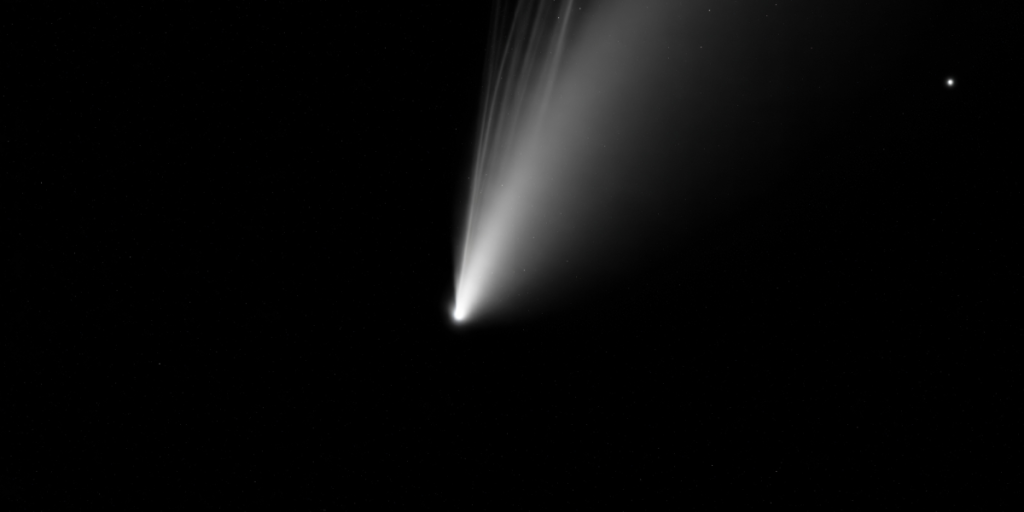The team have designed a mission profile, that could have made it possible.
Others are reading now
For decades, astronomers have only glimpsed interstellar visitors through the powerful eyes of telescopes.
Now, a team of researchers believes we might soon be able to meet one face to face.
Discovered in July 2025, comet 3I/ATLAS has captured global attention as it sweeps through the Solar System from the depths of interstellar space.
Observatories on Earth, space telescopes such as Hubble, and even orbiters around Mars have all joined in watching its fleeting journey.
But while telescopes can only observe from afar, a group of scientists from the Southwest Research Institute (SwRI) in Texas say the next step could be to send a spacecraft to chase and study one directly — and, remarkably, it may already be possible.
Also read
Studying alien relics
According to the SwRI team, their newly completed mission study outlines how a spacecraft could conduct a flyby of an interstellar comet.
The researchers say such a close encounter could reveal unprecedented insights into how planetary systems beyond our own are built.
Comets and asteroids are ancient remnants from the Solar System’s birth, preserving clues about its early chemistry and evolution. Interstellar comets like 3I/ATLAS, however, come from entirely different star systems — making them invaluable time capsules of cosmic history.
By examining these travelers, scientists could compare material from distant stars with the building blocks that formed Earth and its neighbors, potentially revealing how unique or common our Solar System truly is.
Blueprint for a mission
The SwRI study explored spacecraft design, scientific goals, and the practical steps needed to intercept an interstellar object.
Also read
The team even found that 3I/ATLAS itself could have been reached with their proposed mission profile.
So far, astronomers have spotted only three interstellar visitors: 1I/‘Oumuamua in 2017, 2I/Borisov in 2019, and 3I/ATLAS in 2025. But new observatories such as the Vera Rubin Observatory, which began operations this year, are expected to dramatically increase the discovery rate.
“This new generation of observations could open the door to direct exploration of material from other star systems,” said Dr. Alan Stern, planetary scientist and associate vice president at SwRI, said in a statement.
He added: “An ISC flyby could give unprecedented insights into the composition, structure and properties of these objects, and it would significantly expand our understanding of solid body formation processes in other star systems.”
Charting the unknown
The proposed mission would rely on a high-speed, head-on flyby, collecting vast amounts of data during the brief encounter. SwRI project manager Matthew Freeman said such a mission could serve as a prototype for future visits to other interstellar travelers.
Also read
While capturing a comet in orbit is still far beyond current capabilities, the team says flybys are achievable using existing technology. Their design includes instruments to analyze a comet’s surface, internal structure and the glowing coma — the cloud of gas that forms as a comet’s ice evaporates near the Sun.
Understanding an interstellar comet’s physical properties could help scientists trace its origins and learn how the harsh conditions of deep space shape these frozen relics over millions of years.
A realistic pursuit
To test feasibility, the researchers created a computer model simulating the orbits of potential interstellar objects and the energy needed for interception.
Their findings were promising: a low-energy trajectory from Earth could be achieved with existing propulsion systems.
SwRI orbital mechanics specialist Dr. Mark Tapley calculated that a spacecraft designed under these parameters could have reached 3I/ATLAS.
Also read
“The very encouraging thing about the appearance of 3I/ATLAS is that it further strengthens the case that our study made,” he said.
“We demonstrated that it doesn’t take anything harder than the technologies and launch performance like missions that NASA has already flown to encounter these interstellar comets.”
As the search for cosmic visitors accelerates, scientists believe the first mission to chase a comet from another star could happen sooner than imagined — marking a bold new step in humanity’s exploration of the universe.
Sources: NASA, Southwest Research Institute, Reuters, BBC, AP


